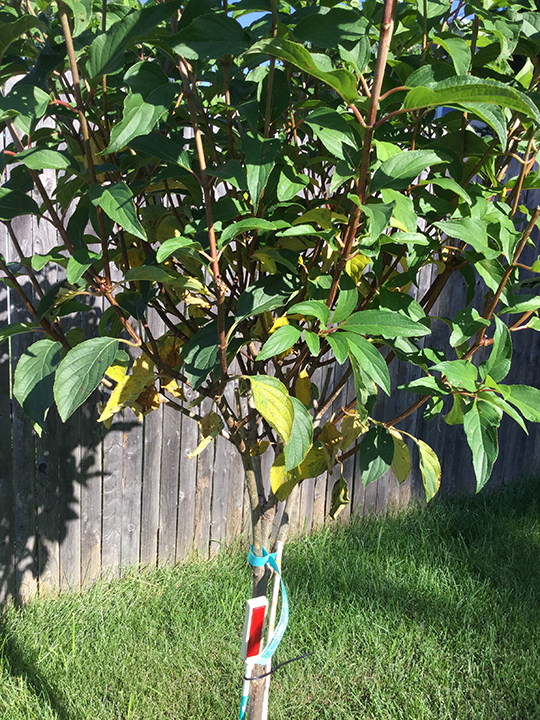The Best Strategy To Use For Hydrangea Leaves Turning Yellow
Table of ContentsThe 8-Minute Rule for Hydrangea Leaves Turning YellowThe Only Guide for Hydrangea Leaves Turning YellowOur Hydrangea Leaves Turning Yellow DiariesThings about Hydrangea Leaves Turning YellowHydrangea Leaves Turning Yellow - TruthsHow Hydrangea Leaves Turning Yellow can Save You Time, Stress, and Money.
Large fallen leaves usually look sagging throughout the mid-day warmth. When they fail to perk up in the night or still look wilted in the morning, your plant could be overwatered.Remove the plant from the soil and prune out any type of roots that aren't white and swollen (plump) (Hydrangea Leaves Turning Yellow). Replant in a brand-new location or function some sand right into the dirt for much better water drainage. Underwatering additionally triggers entrusts to transform yellow with brownish, crispy sides. Don't attempt to deal with the problem by watering excessively.

What Does Hydrangea Leaves Turning Yellow Mean?
Initially appears on the older fallen leaves, however the leaf blood vessels stay environment-friendly. A magnesium deficiency appears initially on old fallen leaves and should not be puzzled with an iron deficiency [Photo: izzzy71/ Shutterstock. com] While there is generally adequate iron in all-natural dirt, hydrangeas typically battle to soak up enough of it.
The best way to avoid iron deficiency-chlorosis in hydrangeas is to plant them in appropriate ericaceous or acidic soil. When growing in a bed, mix in some peat or reduced-peat ericaceous compost and check the p, H value yearly. This is required since the garden compost combination around the plants will certainly influence the p, H value of the dirt in the future and the p, H value may rise again.

Little Known Facts About Hydrangea Leaves Turning Yellow.
September is the finest time of year to do something regarding those hydrangeas. Their leaves are transforming yellow, the flowers have discolored, and their gangly appearance is making you insane.
Mophead, Lacecap and Oakleaf hydrangeas flower on old timber. Do not trim Mophead, Lacecaps and Oakleaf hydrangeas to the ground, as you will certainly get rid of the stems that are all set to flower next spring.
In this way you will not be eliminating also many of next year's blossom buds. Trim out as much dead timber as you can discover. You can reduce nonessential down to the ground. If the bush is getting larger than you like, you can get a third of the live timber while you remain in there.
Hydrangea Leaves Turning Yellow for Beginners
We're appropriate in the middle of our late-blooming hydrangea period here, so I assumed I 'd share a pointer for this particular sort of hydrangea that I found truly interesting. A great deal of people have a similar problem with their panicle hydrangeas where they start to see the leaves turning yellow and dropping off at different components of the period and it can be quite dramatic and pretty worrying because it can happen truly quickly on a bush that looks like it's or else truly healthy and balanced.
I've shared it on Instagram prior to, yet I recognized I have actually never informed you regarding this in an actual, full post, so today I'm caring for that. When I state that this applies to panicle hydrangeas, that indicates the sort of more helpful hints hydrangeas that usually flower later read more on in summer, generally around August.
Where we stay in zone 6, they're quite simple to have success with and they're truly popular in our area, which is wonderful because that means that there are hydrangeas nearly all over currently of year. When you see your hydrangea leaves starting to turn yellow, you might assume that your plant is dying or being maltreated in some way, yet actually, the reverse is real.
Get This Report about Hydrangea Leaves Turning Yellow

Courtenay is the writer of the publication The Cleaning Ninja and has been included in numerous magazines consisting of Nation Sampler Farmhouse Design, Better Houses and Gardens, Parents Publication, Real Simple, and Our Residences.
Waterlogged soil robs the roots of oxygen, leading to root rot and yellow fallen leaves. On the other hand, underwatering or dehydration creates the plant to shrivel and its vegetation to yellow. Keeping a constant watering schedule and guaranteeing appropriate drainage with drain openings or layers can help avoid these issues.
Fascination About Hydrangea Leaves Turning Yellow
Regularly inspect the dirt level of acidity, and change as needed to preserve the ideal p, H level for hydrangeas. With correct treatment and upkeep, hydrangeas can thrive look at this website and keep their dazzling, vivid leaves. Hydrangea leaves turning yellow is a common problem that can be connected to different elements. Among the primary factors is incorrect watering, as hydrangeas call for regularly moist soil to flourish.
The sort of yellowing seen (e. g. the placement of the influenced fallen leaves on the plant, and/or the pattern and position of the yellowing on the leaf itself) will certainly commonly vary according to the cause. The chlorosis is regularly accompanied by various other symptoms providing more hints regarding the reason, e.Examples include sap-sucking parasites such as aphids, red spider termites and whiteflies, and origin feeders such as vine weevil and cabbage root fly. Once once again it is often feasible to locate the offender on the fallen leaves or amongst the origins.